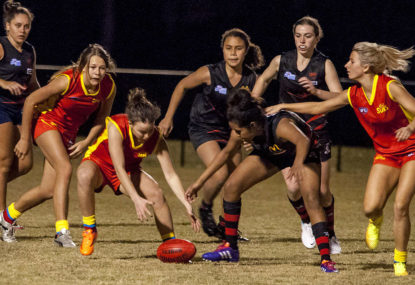LISTEN: 'Presidents don't want 19 teams' - Eddie McGuire's dire warning to North Melbourne
The former Collingwood president says the Kangaroos need to 'stand for something' not just on the field but in the community or risk being…

This has been a great week for women’s sport in Australia, with two significant announcements on the same day.
In women’s rugby union, the Wallaroos – Australia’s national women’s team- now has a sponsor, and will be playing against the New Zealand Black Ferns in a series of two Tests in October.
This announcement is a major boost to the women’s game in advance of next week’s National Women’s Rugby XV Championship being played in Sydney and in the lead up to the Wallaroos competing in the 2017 Women’s Rugby World Cup in Ireland.
On the same day, the AFL announced that a National Women’s League would be launched in 2017, with eight clubs granted full licences to compete over a season of six matches beginning in February.
A further five provisional licences have been granted, with those clubs potentially joining the competition in future years.
Unsurprisingly, much of the discussion has focused on the AFL announcement. One commentator has suggested that the AFL women’s league, bringing player payments and profile, has the potential to impact on other more established women’s sporting competitions including netball, basketball, hockey, soccer, cricket and softball.
Really? Isn’t the end game the need to increase women’s participation rates in sport and activity in general, and not for well-resourced codes to cannibalise other established competitions?
Is the establishment of the new league primarily a business development opportunity aimed at increasing AFL club memberships, or is it based on building the game at a community level?
In developing the women’s league, the AFL will need to address a number of challenges. Firstly, many of the games that are more traditionally played by women have an international presence.
This means that even at the junior and schools level, these other sports offer an opportunity to travel and play in many different countries. At the elite level, Australian women’s teams have enjoyed a strong record of success on the international stage from hockey, netball, water polo and more recently rugby sevens.
In addition, it will be interesting to see how the game of AFL is equipped to deal with diversity in its full sense, while a culture of fans booing remains part of the game. Do women AFL players really want the level of media intrusion currently provided to their male counterparts, while elite athletes in other sports enjoy a level of anonymity (admittedly with requisite lower levels of pay)?
Overall, the establishment of the National Women’s League and the bolstering of support for our national women’s rugby team are great developments for women who want to participate in or watch sport played by women.
With a greater variety of sports on offer, girls of all abilities, interests and body shapes may find an activity that bests suits them. Let us hope that the overall effect is greater participation rates of women at a grass roots level across all sports.